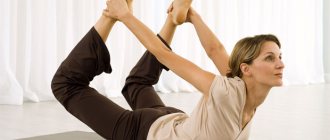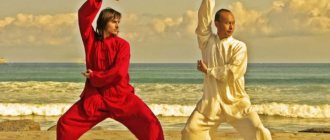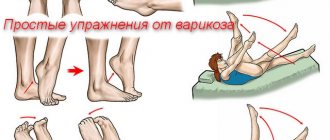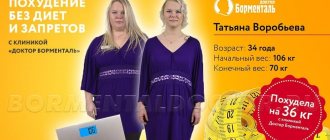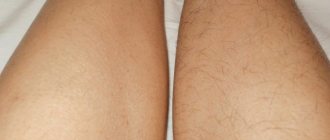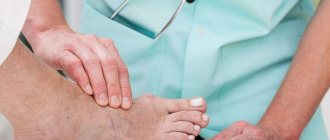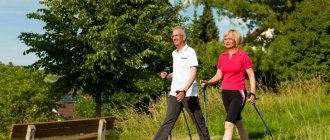Physical activity for atherosclerosis - lasting 30 minutes a day with increased heart rate and sweating - is an indispensable aid in preventing the development of diseases and for cleansing blood vessels of cholesterol plaques. Acceptable physical activities for vascular atherosclerosis include walking, swimming, running, cycling, skating, skiing, snowboarding, Nordic walking... But no physical activity is a 100% guarantee of preventing the development of atherosclerosis, the occurrence of coronary heart disease (CHD), heart attacks and (or ) stroke, especially with a corresponding family history and does not guarantee 100% clearing of blood vessels from cholesterol.
Benjamin Franklin recommended climbing stairs for 15 minutes every day. Already modern researchers - from Geneva, however - conducted observations of people who were asked to use the stairs instead of the elevator for 12 weeks. Climbing 100 – 150 floors per week turned out to be equivalent to 8 – 12 minutes of daily exercise: this does not seem like much at first glance, but it gave a 10% increase in endurance, weight loss, reduction in high cholesterol and a drop in blood pressure.
Exercise does not help atherosclerosis, although it does help reduce high levels of low-density lipoprotein cholesterol (LDL, often called “bad” cholesterol). Physical exercises with vascular atherosclerosis can also be dangerous (the most famous case in foreign literature is that of Jim Fix), especially if during their implementation such symptoms as compression and pain in the chest, shortness of breath, etc. appear. Regular physical activity, physical education, therapeutic exercises and amateur sports are good for health, if you do not ignore the warning signs of cardiovascular diseases and other symptoms of high cholesterol in the blood.
Sports for atherosclerosis
Playing sports with atherosclerosis can lead to a heart attack, because exercise causes increased heart rate and increased blood pressure (especially when cholesterol plaques accumulate in the vessels of the heart). The degree of risk of a heart attack during exercise depends on the person's level of training: as a rule, tension in well-trained people is associated with very little risk, and, conversely, in untrained people even simple physical work can trigger an attack. Although 5 to 10% of heart attacks occur after vigorous physical activity, in the long term, physically active people live longer.
Is it possible to play sports with vascular atherosclerosis?
Even those who have never been particularly active before can go in for sports with atherosclerosis of the blood vessels of the circulatory system - the main thing is to start slowly and smoothly (so as not to provoke the rupture of a cholesterol plaque in the head, heart or vessels of other organs and tissues) and adhere to the sports program constantly and continuously. The better your physical fitness, the lower the risk to your heart from playing sports.
It is recommended to play sports - perform aerobic exercise - at least 5 times a week: for those who are just starting to exercise, it will take 3 - 6 weeks to enter the regime. You should start with regular or Nordic walking (especially if you have back problems - Swedish walking unloads the spine), for about 20 minutes, moving at a speed slightly higher than usual (3 - 5 km/h for a middle-aged man). If such activity already causes chest pain (angina) or shortness of breath, you should consult a doctor.
We recommend that you read before starting training:
Can cholesterol plaque come off?
Light sports for vascular atherosclerosis reduce the risk of developing coronary heart disease (angina and ischemia). Regular exercise in middle age reduces the risk of death from cardiovascular diseases by 40–50%. The minimum training time is half an hour a day. However, the more the merrier. Athletes who engage in daily or almost daily physical activity, preferably outdoors (such as running), live on average 5 years longer than others. Daily walks of at least half an hour are considered necessary.
Studies have shown that people who ignore any sports between the ages of 18 and 30 have higher cholesterol levels and more cholesterol plaques in their blood vessels, and are more susceptible to developing diabetes and hypertension. The health risks for them are twice as high as for people who regularly engage in any sport. And so that sport (physical education) does not get boring, it can be presented in any game or entertainment and even business form: golf, badminton, tennis, swimming, basketball, football...
Yoga treatment
Yoga and qigong are used primarily for atherosclerotic vascular lesions of the lower extremities. Preference is given to exercises aimed at toning and stretching the muscles:
- bending forward from a sitting or standing position;
- “child” asana (sitting on your heels, lie with your body on your hips and rest your forehead on the floor, stretch your arms forward);
- “dog” asana (spread your legs wider than your shoulders, lean forward, rest your hands on the seat of a chair or, if flexibility allows, on the floor, legs and back remain straight);
- twisting asanas - while sitting on the floor, place your left leg bent at the knee over your right, then your right leg over your left; you can also perform asanas while lying in bed.
Yoga can be combined with breathing practice if there are no contraindications.
Acceptable sports for atherosclerosis
With advanced atherosclerosis and diagnosed coronary artery disease - in the presence of symptoms such as chest pain, shortness of breath - the patient must first undergo a stress test in order to select a safe (and useful) type of physical activity and the permissible intensity of physical activity. In general, aerobic exercises are necessary and safe, which, moreover, have a differentiated effect (more is better).
Physical activity in relation to patients with heart disease is sometimes referred to as cardiac rehabilitation (cardiac regab. - in foreign literature). Cardiac rehabilitation involves adherence to a special diet, weight control (body mass index, BMI), cessation of smoking and alcohol abuse, treatment of concomitant diseases (primarily diabetes, hypertension, atherosclerosis and hypercholesterolemia). The same aerobic exercise reduces insulin resistance.
Any sports for atherosclerosis help improve the lipid profile (reduce LDL levels and increase HDL - high-density lipoproteins, "good" cholesterol: more about how to increase good cholesterol levels), get rid of excess weight, improve heart performance and increase blood flow - even after angioplasty, stenting or coronary bypass surgery. Walking is the simplest and most accessible exercise for almost everyone, but it can be replaced and supplemented with running, rowing, cycling, skiing (or training on an elliptical trainer), and swimming.
Symptoms of atherosclerosis of the lower extremities
The first symptoms of the disease appear when blood circulation is already impaired and blood access to tissues is difficult. The patient experiences symptoms such as:
- rapid fatigue during physical activity (usually walking),
- intermittent claudication (pain in the legs that occurs when walking and subsides after a short rest),
- due to disruption of the nutrition of nerve fibers, goosebumps, numbness and convulsions occur,
- the skin on the legs turns pale,
- the temperature of the affected limb decreases,
- muscle atrophy (with unilateral damage, it is easy to notice the difference in volume between the healthy and diseased leg),
- the hair on your legs becomes thinner and falls out,
- the nails and skin on the feet thicken and become rough.
Physiotherapy for atherosclerosis
Physiotherapy and physiotherapy for atherosclerosis of blood vessels is in the nature of moderate physical activity, which helps to increase the level of beneficial HDL cholesterol by about 5%, or by 2 - 3 mg/dl. More dynamic (vigorous) exercise, such as running, increases the concentration of good cholesterol even more, but even 1 mg/dL is enough to reduce the risk of coronary heart disease by 3%. At the same time, exercises from the physiotherapy program (physical therapy), like any sport, however, reduce the level of LDL and triglycerides.
The goal of physiotherapy for atherosclerosis of the carotid arteries, coronary vessels, blood vessels of the extremities, etc. is also to suppress inflammatory processes in the vessels, which are usually associated with the development of atherosclerosis and ischemia (many patients with coronary artery disease are in a state of persistent inflammation and physiotherapy can reduce inflammatory reactions). People who exercise systematically and regularly have lower blood levels of C-reactive protein (a key indicator of inflammation).
Also, sports and physical therapy for atherosclerosis help increase blood flow, stimulate the functioning of the cardiovascular system, and control weight. With 30 minutes of daily physical activity, the average weight gain is 3 kg less over 20 years (and for women - 7 kg less). Therapeutic exercise is also effective for the prevention of diabetes (see also: nutrition for high sugar and cholesterol).
Finally, physical therapy and physical therapy exercises for vascular atherosclerosis increase the elasticity of the endothelium, the inner lining of the arteries, which helps the coronary arteries expand, increasing blood flow to the heart. Elastic blood vessels are less susceptible to damage (and damage not only impedes blood flow, but also leads to the appearance of atherosclerotic plaques nearby). Physical therapy exercises promote the production of nitric oxide and proteins necessary to maintain the integrity of the endothelium, which reduces the rate of development of atherosclerosis if the level of cholesterol in the blood is elevated.
Nitric oxide causes the so-called pumping effect - a visual increase in muscle mass after training. Pumping is one of the training goals of bodybuilders and fitness. It is a mistake to think that exercises with weights (resistance exercises - simply put, with a barbell and dumbbells, on the horizontal bar and uneven bars: lifting weights) are exclusively harmful to the heart - on the contrary, moderate training - 2 times a week - has a positive effect on the functioning of the heart. vascular system: resting blood pressure decreases in the long term, blood sugar levels normalize, weight is maintained.
Strength training is also beneficial for the following reasons:
- for every 0.5 kg of muscle mass, the body burns 10 additional calories per day, which helps to lose weight;
- in older adults, strength training prevents loss of bone density.
Obliterating arterial diseases
Obliterating arterial diseases (obliterating atherosclerosis and obliterating endarteritis) develop as a result of changes in the structure of the arterial wall. These changes contribute to the narrowing of the lumen of the vessel, and the blood clots formed in it make it completely impassable for blood. With obliterating atherosclerosis, changes occur (see “Atherosclerosis”) in the aorta, iliac arteries and arteries of the lower extremities. With obliterating endarteritis, the inner lining of medium and small arteries grows, closing their lumen. Changes in the structure of the walls of blood vessels are often accompanied by their spasm. All this worsens the blood supply to the lower extremities and first causes complaints of chilliness, numbness of the fingers and feet, rapid fatigue of the legs, cramps of the calf muscles (stage I), then intermittent claudication (pain appears when walking and goes away during rest) and initial trophic changes ( Stage II), with more significant disturbances in the blood supply, pain occurs even at rest, trophic changes become pronounced (stage III), gangrene of the fingers and feet develops (stage IV).
The development of the disease is promoted by smoking, cooling the feet, and neuropsychic injuries. During treatment, vasodilators and blood clotting agents are used. When indicated, plastic surgery on the vessels is performed, restoring the patency of the arteries, and sympathectomy (removal of sympathetic nodes), as a result of which the tone of the arteries decreases and blood flow through the collaterals increases.
The objectives of therapeutic physical culture are: general strengthening of the body, improvement of peripheral blood circulation and metabolic processes in the affected limbs, development of collaterals and restoration of full regulation of blood circulation. It is especially important to achieve good development of collaterals, since they can replace damaged vessels. In this way a high degree of compensation is achieved.
For stages I and II of the disease, the introductory part of therapeutic exercises includes exercises for the upper limbs and torso, breathing exercises, and walking. The main part uses a large number of special exercises in alternation with general developmental exercises for healthy limbs and torso and breathing exercises. Special exercises include dynamic exercises for the affected limb, exercises in static tension and muscle relaxation, exercises with changing the position of the affected limb. In the final part, muscle relaxation exercises, breathing exercises, and sedentary games are used.
Important methodological techniques that allow you to increase the load on the affected limb are: alternating exercises of different nature, using exercises first for large muscle groups of the affected limb, then for small ones, frequently changing the starting positions of standing, sitting and lying. The number of repetitions in leg exercises should be such as not to cause pain.
Therapeutic physical culture is indicated for obliterating endarteritis, obliterating atherosclerosis of the arteries of the extremities and after reconstructive operations on peripheral vessels. It improves the functional state of the cardiovascular system, peripheral circulation and compensatory development of muscle collaterals, regulates angiospastic reactions, and increases muscle performance.
Special gymnastic exercises for the legs are used - dynamic, with relaxation and measured muscle effort while lying and sitting, alternating with various types of walking, breathing and general strengthening exercises for the body and healthy limbs. It is recommended to frequently change starting positions (lying, sitting and standing) in order to improve blood circulation in the legs. Prolonged static tension of the leg muscles should be avoided. Dosed walking and skiing, rowing and swimming in warm water are useful. The dosage of exercises depends on the degree of vascular-trophic disorders of the limbs and damage to the blood vessels of other organs (coronary, cerebral). Exercise therapy is contraindicated in acute vascular thrombosis, migratory thrombophlebitis, and gangrene.
An approximate set of exercises for obliterating arterial diseases
1. Starting position - sitting on a chair. Hands up - inhale, and. p. - exhale. 4-6 times.
2. I. p. - the same, hands to shoulders, elbows to the sides. Rotation in the shoulder joints in different directions. Breathing is voluntary. 16-20 times.
3. I. p. - sitting astride a chair facing the back, hands on the back of the chair. Right leg to the side, with your right hand reach for its toe - exhale, and. n.—inhale. Same with the left foot. 6-8 times.
4. I. p. - the same. Straightening your arms, bending back - inhale, and. p. - exhale. 6-8 times.
5. I. p. - main stand. Rise on your toes, hands behind your head, hands up - inhale, hands behind your head, etc. p. - exhale. 5-8 times.
6 “I. p. - the same. Relaxed shaking of the leg muscles. 3-5 times with each leg.
7. I. p. - standing, hands on the belt. Torso rotation. 6-8 times in each direction.
8. I. p. - standing, feet shoulder-width apart, hands on the belt. Bend your left leg and transfer the weight of your body onto it. Same with the right foot. 8-12 times.
9. I. p. - standing with your right side to the back of the chair, holding onto it with your right hand. Swing your left leg back and forth, relaxing the leg muscles. Do the same with your right foot, standing with your left side to the chair. 8-10 times.
10. I. p. - basic stance, left arm bent at the elbow joint, fingers clenched into a fist. Changing the position of the hands. 16-20 times.
11. Walking as usual, walking with high knees. 1-2 min.
12. I. p. - main stand. Hands to the sides - inhale, and. p. - exhale. 5-6 times. ;
13. I. p. - lying on your back. Pull the leg bent at the knee towards your stomach with your hands - exhale, and. n.—inhale. 8-10 times with each leg.
14. I. p. - lying on your back, legs slightly bent at the knees, raised at an angle of 60-90°, hands supporting them by the back of the thighs. Flexion and extension of the feet (at a pace of 1 time per 1 s). The number of repetitions is until fatigue appears (but not to the point of pain!). Sit down with your legs down, imagine and feel how they gradually warm up and fill with blood. 2-3 min.
15. I. p. - sitting on a chair. Relaxed shaking of the leg muscles. 4-6 times.
16. I. p. - sitting, hands on the belt. Pull your elbows back, bend over - inhale, and. p. - exhale. 4-6 times.
17. I. p. - lying on your back at the edge of the bed. Lower your leg to the floor - inhale, raise your leg - exhale. 10-12 times with each leg.
18. I. p. - lying on your back. Diaphragmatic-thoracic breathing. 4-5 times. 19. I. p. - the same. Alternately moving your legs to the side. 10-12 times with each leg.
20. I. p. - standing, holding the back of a chair. Sit down - exhale, and. p. - inhale, 6-10 times.
21. Repeat exercise 9.
22. I. p. - standing, holding the back of a chair. Bend back - inhale, bend forward, bending your arms - exhale. 6-8 times.
23. I. p. - sitting on a chair. Rotation of feet. 10 times in each direction.
24. I. p. - the same. Lifting your heels off the floor, tighten your calf muscles (2-4 sec); lowering your heels to the floor, relax (4-6 s). 5-10 times.
25. I. p. - the same. Relaxation and shaking of the leg muscles. 4-6 times.
26. I. p. - the same. Hands to the sides - inhale, and. p. - exhale. 4-6 times.
Among other forms of therapeutic physical education, measured walking plays an important role. The distance, walking speed, and rest time are selected individually so as not to cause pain in the legs. At the first signs of fatigue, the speed and distance of measured walking are reduced, and if pain appears, rest is given. The load increases by lengthening the distance and then the speed of movement.
In stage III of the disease, at the beginning of the course of treatment, exercises are used only for healthy limbs, torso and breathing exercises, and when the condition improves, special exercises begin to be used carefully.
Therapeutic exercises for vascular atherosclerosis
Therapeutic gymnastics and physical exercise for vascular atherosclerosis also have a positive effect on the level of arterial (upper, or systolic) pressure, sometimes acting as a prevention of hypertension. Regular physical activity reduces blood pressure by up to 10 mm Hg. Art., which is not bad in itself, and in the context of the development of atherosclerosis: high pressure acts on the walls of blood vessels like a battering ram, forming damage in them, which overgrow with new atherosclerotic plaques.
CM. Also:
Cholesterol formation in the human body
Increased blood flow as a result of physical exercise improves the nutrition of the heart muscle (myocardium), which is effective even for patients with ischemia - however, this effectiveness does not lie in the fact that new (bypass) blood vessels are supposedly formed and not in the remission of coronary artery disease (which is also a myth).
Therapeutic exercises for atherosclerosis of blood vessels - arteries and veins - should include flexibility exercises: observations show that the higher the flexibility of joints and muscles, the more elastic the walls of blood vessels. There is even a simple test: sitting with your legs straight, try to reach with your hands to the tips of your toes - the further you manage to bend, the higher the elasticity of the blood vessels. The idea of including flexibility and stretching exercises in a physical therapy program seems quite successful.
Therapeutic exercises for atherosclerosis can be gleaned from a Pilates or stretching training program, as well as yoga. Any physical exercise reduces the stickiness of blood clots, which has a beneficial effect on the formation of blood clots. Plus, sports and therapeutic exercises promote the synthesis of proteins that thin the blood. In addition, the elastic endothelium itself resists the formation of blood clots.
See also:
Exercise therapy for cerebral atherosclerosis
How to reduce blood cholesterol with diet
What foods cleanse cholesterol plaques?
List of anti-cholesterol foods
A set of exercises for the vessels of the brain and neck
Therapeutic exercises for cerebral atherosclerosis have a single goal - to relieve spasms in the neck and upper back, and reduce muscle tension in the back of the head and neck. Intense exercise with this type of atherosclerosis is contraindicated, so all exercises are either static or involve the least amount of body tension.
The following exercises are recommended:
- Imitation of steps while lying down. At the same time, the hands make waving movements towards the leg that is in motion: the right hand is brought to the left thigh, the left to the right. The shoulders remain pressed to the surface.
- Lying on your back, bring your knees to your chest, lightly holding your shin with your hands. First the right leg, then the left, and so on 10 times per limb. The head remains lying on the surface, the neck muscles are relaxed.
- Raising your arms while standing. The arms close in front of the body, then rise as you inhale (do not open the hands!). Hold for 2-3 seconds and slowly lower. Repeat 10-15 times.
- Seated arm raises. The knees are wide apart, the hands rest on the surface of the thighs, the elbows are wide apart, the chin is lowered to the chest. As you inhale, your arms are spread to the sides, straightened in a position parallel to the floor, and your head is slightly raised. As you exhale, the upper limbs return to their original position, the chin drops to the chest.
In the absence of severe dizziness, patients are allowed to perform neck exercises. To do this, tilt your head back and forth and to the sides. At the same time, they try to keep their shoulders turned and their back straight.
How does exercise therapy work?
The use of various physical exercises has, firstly, a tonic effect: the patient’s mood rises, due to which the functioning of the central nervous system noticeably improves, and protective processes aimed at recovery are activated.
Secondly, metabolism and cardiac blood supply improves. These phenomena increase the contractility of the myocardium, strengthening it, and gradually normalize cholesterol levels. Among other things, exercises, especially breathing ones, enhance the body’s restorative functions, that is, a person will be able to cope with vascular disease faster.
Thus, the main tasks of exercise therapy for atherosclerosis can be called:
- Strengthening the cardiovascular system;
- Improving blood circulation and central nervous system function;
- Normalization of metabolism.
